Integrated Natural Gas, Heat, and Power Dispatch Considering Wind Power and Power-to-Gas
Abstract
:1. Introduction
- (1)
- A novel framework of an integrated energy system considering wind power and P2G is proposed (as depicted in Figure 1), in which a natural gas system, heating system, and power system are included. The INGHPD model, aimed at minimizing the system operation cost, is proposed.
- (2)
- A natural gas network is modeled and its system constraints are taken into account in the optimal dispatch model.
- (3)
- P2G is integrated into the dispatch model and its benefits in reducing the wind power curtailment, system operation cost, and CO2 emissions are evaluated. Factors influencing the performance of P2G are also investigated.
2. Related Work
3. Model of Integrated Natural Gas, Heat and Power System
3.1. Structure of Integrated Natural Gas, Heat, and Power System
3.2. CHP Unit
3.3. Natural Gas Network
3.4. Power to Gas
3.5. Natural Gas-Fired Unit
4. Formulation of INGHPD Model
4.1. Objective Function
4.2. Constraints
- (1)
- Power balance constraints: The power demand is satisfied by NGFUs, CHP units, and wind power.
- (2)
- Heat balance constraints: The heat demand is satisfied by the CHP units only.
- (3)
- Power output constraints of NGFUs: The power outputs of the NGFUs are constrained by their technical limits.
- (4)
- Ramping rate constraints of NGFUs and CHP units: The incremental power outputs of the power generation units are restricted by their maximum ramping rates.
- (5)
- Power output constraints of wind farms: The integrated wind power should not exceed its forecasted wind power.
- (6)
- Spinning reserve constraints: A certain level of spinning reserve capacity is required to deal with the system contingencies.
- (7)
- Power transmission constraints: Transmission flow should not exceed the transmission capacity.
4.3. Robust Optimization Model
5. Case Study
5.1. System Description
5.2. Scenarios
5.3. Results and Analysis
5.3.1. Necessity of Considering Natural Gas System Constraints
5.3.2. Effect of P2G on Wind Power Curtailment, Fuel Cost, and CO2 Emission
5.3.3. Impact of Power and Heat Demand on P2G
5.3.4. Impact of P2G Capacity on Wind Power Integration
5.3.5. Robust Optimization Result
6. Conclusions
Acknowledgments
Author Contributions
Conflicts of Interest
Nomenclature
| Index Sets: | |
| Index set of CHP units | |
| Index set of gas supplies | |
| Index set of natural gas loads | |
| Index set of buses | |
| Index set of gas nodes connected with m | |
| Index set of P2G units | |
| Index set of NGFUs | |
| Index set of wind power units | |
| Uncertainty set of available wind power | |
| Uncertainty set of power demand | |
| Uncertainty set of heat demand | |
| T | Index set of dispatch time steps |
| J | Index set of extreme characteristic points |
| Input Parameters and Functions: | |
| , , | Power production, heat production and gas consumption cost of extreme characteristic point j |
| Gas consumption cost of CHP i at time t | |
| / | Lower/upper limit of gas supplier i |
| Lower/upper limit of gas load i | |
| Pipeline constant | |
| Lower/upper limit of nodal pressure | |
| Lower bound of gas flow in the pipeline | |
| Gas flow of block l | |
| Slope of block l | |
| Lower limit of block l of piecewise linear function | |
| A/B | Node-gas supplier/load incidence matrix |
| Conversion efficiency of P2G unit i | |
| Capacity of P2G unit i | |
| Higher heating value of natural gas (39.5 MJ/m3) | |
| / | Maximum downward/upward ramping rate of P2G unit i |
| Power plant efficiency of NGFU unit i | |
| Natural gas cost of NGFU unit i at time t | |
| Price of natural gas | |
| Forecasted power demand of the system at time step t | |
| / | Minimum/maximum power output of NGFU unit i |
| / | Maximum downward/upward ramping rate of unit i |
| Forecasted wind power at time t | |
| Forecasted heat demand of the system at time t | |
| Power load at bus n at time t | |
| Transmission capacity limit of line l | |
| / | System upward/downward spinning reserve capacity requirement |
| Power transfer distribution factor from bus n to line l | |
| / | Maximum downward/upward deviation of wind power from the forecasted value |
| / | Maximum downward/upward deviation of power demand from the forecasted value |
| / | Maximum downward/upward deviation of heat demand from the forecasted value |
| Decision Variables: | |
| Power production of thermal power unit i at time t | |
| Heat production of thermal power unit i at time t | |
| Wind power integrated to the power system at time t | |
| Combination coefficient of extreme characteristic point j | |
| Gas supply of node i at time t | |
| Gas load of node i at time t | |
| Gas flow between node m and n | |
| / | Pressure of node m/n |
| Energy content of produced natural gas from P2G unit i at time t | |
| Volumetric quantity of natural gas produced by P2G i at time t | |
| Consumed electric power of P2G unit i at time t | |
| Uncertain Parameters: | |
| Actual available wind power of wind farm i at time t | |
| Actual power demand at time t | |
| Actual heat demand at time t | |
References
- Feng, Y.; Lin, H.Y.; Ho, S.L.; Yanc, J.H.; Dong, J.N.; Fang, S.H.; Huang, Y.K. Overview of Wind Power Generation in China: Status and Development. Renew. Sustain. Energy Rev. 2015, 50, 847–858. [Google Scholar] [CrossRef]
- Madlener, R.; Schmid, C. Combined Heat and Power Generation in Liberalised Markets and a Carbon-Constrained World. GAIA-Ecol. Perspect. Sci. Soc. 2003, 12, 114–120. [Google Scholar]
- Jiang, L.P.; Wang, C.X.; Huang, Y.H.; Pei, Z.Y.; Xin, S.X.; Wang, W.S.; Ma, S.; Brown, T. Growth in Wind and Sun Integrating Variable Generation in China. IEEE Power Energy Mag. 2015, 13, 40–49. [Google Scholar] [CrossRef]
- Cong, L.; Shahidehpour, M.; Zuyi, L.; Fotuhi-Firuzabad, M. Component and Mode Models for the Short-Term Scheduling of Combined-Cycle Units. IEEE Trans. Power Syst. 2009, 24, 976–990. [Google Scholar] [CrossRef]
- Shahidehpour, M.; Yong, F.; Wiedman, T. Impact of Natural Gas Infrastructure on Electric Power Systems. Proc. IEEE 2005, 93, 1042–1056. [Google Scholar] [CrossRef]
- Li, T.; Eremia, M.; Shahidehpour, M. Interdependency of Natural Gas Network and Power System Security. IEEE Trans. Power Syst. 2008, 23, 1817–1824. [Google Scholar] [CrossRef]
- Zhang, N.; Lu, X.; McElroy, M.B.; Nielsen, C.P.; Chen, X.; Deng, Y.; Kang, C. Reducing Curtailment of Wind Electricity in China by Employing Electric Boilers for Heat and Pumped Hydro for Energy Storage. Appl. Energy 2015, 184, 987–994. [Google Scholar] [CrossRef]
- De Boer, H.S.; Grond, L.; Moll, H.; Benders, R. The Application of Power-to-gas, Pumped Hydro Storage and Compressed Air Energy Storage in an Electricity System at Different Wind Power Penetration Levels. Energy 2014, 72, 360–370. [Google Scholar] [CrossRef]
- Reiter, G.; Lindorfer, J. Global Warming Potential of Hydrogen and Methane Production from Renewable Electricity via Power-to-gas Technology. Int. J. Life Cycle Assess. 2015, 20, 477–489. [Google Scholar] [CrossRef]
- Parra, D.; Patel, M.K. Techno-economic Implications of the Electrolyser Technology and Size for Power-to-gas Systems. Int. J. Hydrogen Energy 2016, 41, 3748–3761. [Google Scholar] [CrossRef]
- Qadrdan, M.; Abeysekera, M.; Chaudry, M.; Wu, J.Z.; Jenkins, N. Role of Power-to-gas in an Integrated Gas and Electricity System in Great Britain. Int. J. Hydrogen Energy 2015, 40, 5763–5775. [Google Scholar] [CrossRef]
- Schiebahn, S.; Grube, T.; Robinius, M.; Tietze, V.; Kumar, B.; Stolten, D. Power to gas: Technological Overview, Systems Analysis and Economic Assessment for a Case Study in Germany. Int. J. Hydrogen Energy 2015, 40, 4285–4294. [Google Scholar] [CrossRef]
- Estermann, T.; Newborough, M.; Sterner, M. Power-to-gas Systems for Absorbing Excess Solar Power in Electricity Distribution Networks. Int. J. Hydrogen Energy 2016, 41, 13950–13959. [Google Scholar] [CrossRef]
- Buchi, F.N.; Hofer, M.; Peter, C.; Cabalzar, U.D.; Bernard, J.; Hannesen, U.; Schmidt, T.J.; Closset, A.; Dietrich, P. Towards Re-electrification of Hydrogen Obtained from the Power-to-gas Process by Highly Efficient H-2/O-2 Polymer Electrolyte Fuel Cells. RSC Adv. 2014, 4, 56139–56146. [Google Scholar] [CrossRef]
- Correa-Posada, C.M.; Sanchez-Martin, P. Security-Constrained Optimal Power and Natural-Gas Flow. IEEE Trans. Power Syst. 2014, 29, 1780–1787. [Google Scholar] [CrossRef]
- Correa-Posada, C.M.; Sanchez-Martin, P. Integrated Power and Natural Gas Model for Energy Adequacy in Short-Term Operation. IEEE Trans. Power Syst. 2015, 30, 3347–3355. [Google Scholar] [CrossRef]
- Zhang, X.; Che, L.; Shahidehpour, M.; Alabdulwahab, A.; Abusorrah, A. Electricity-Natural Gas Operation Planning with Hourly Demand Response for Deployment of Flexible Ramp. IEEE Trans. Sustain. Energy 2016, 7, 996–1004. [Google Scholar] [CrossRef]
- Alabdulwahab, A.; Abusorrah, A.; Zhang, X.; Shahidehpour, M. Stochastic Security-Constrained Scheduling of Coordinated Electricity and Natural Gas Infrastructures. IEEE Syst. J. 2015, 3, 1–10. [Google Scholar] [CrossRef]
- Liu, C.; Lee, C.; Shahidehpour, M. Look Ahead Robust Scheduling of Wind-Thermal System with Considering Natural Gas Congestion. IEEE Trans. Power Syst. 2015, 30, 544–545. [Google Scholar] [CrossRef]
- Cong, L.; Shahidehpour, M.; Yong, F.; Zuyi, L. Security-Constrained Unit Commitment with Natural Gas Transmission Constraints. IEEE Trans. Power Syst. 2009, 24, 1523–1536. [Google Scholar] [CrossRef]
- Zhang, X.; Shahidehpour, M.; Alabdulwahab, A.; Abusorrah, A. Hourly Electricity Demand Response in the Stochastic Day-Ahead Scheduling of Coordinated Electricity and Natural Gas Networks. IEEE Trans. Power Syst. 2016, 31, 592–601. [Google Scholar] [CrossRef]
- Alabdulwahab, A.; Abusorrah, A.; Zhang, X.; Shahidehpour, M. Coordination of Interdependent Natural Gas and Electricity Infrastructures for Firming the Variability of Wind Energy in Stochastic Day-Ahead Scheduling. IEEE Trans. Sustain. Energy 2015, 6, 606–615. [Google Scholar] [CrossRef]
- Stephen, C.; Pierluigi, M. Integrated Modeling and Assessment of the Operational Impact of Power-to-Gas (P2G) on Electrical and Gas Transmission Networks. IEEE Trans. Sustain. Energy 2015, 6, 1234–1244. [Google Scholar]
- Jentsch, M.; Trost, T.; Sterner, M. Optimal Use of Power-to-Gas Energy Storage Systems in an 85% Renewable Energy Scenario. Energy Procedia 2014, 46, 254–261. [Google Scholar] [CrossRef]
- Clegg, S.; Mancarella, P. Storing Renewables in the Gas Network: Modelling of Power-to-gas Seasonal Storage Flexibility in Low-carbon Power Systems. IET Gener. Transm. Distrib. 2016, 10, 566–575. [Google Scholar] [CrossRef]
- Zeng, Q.; Fang, J.; Li, J.; Chen, Z. Steady-state Analysis of the Integrated Natural Gas and Electric Power System with Bi-directional Energy Conversion. Appl. Energy 2016, 184, 1483–1492. [Google Scholar] [CrossRef]
- Chen, X.Y.; Kang, C.Q.; Mark, O.; Xia, Q. Increasing the Flexibility of Combined Heat and Power for Wind Power Integration in China Modeling and Implications. IEEE Trans. Power Syst. 2015, 30, 1848–1857. [Google Scholar] [CrossRef]
- Li, Z.G.; Wu, W.C.; Shahidehpour, M.; Wang, J.H.; Zhang, B.M. Combined Heat and Power Dispatch Considering Pipeline Energy Storage of District Heating Network. IEEE Trans. Sustain. Energy 2016, 7, 12–22. [Google Scholar] [CrossRef]
- Yang, Y.L.; Wu, K.; Long, H.Y.; Gao, J.C.; Yan, X.; Kato, T.; Suzuoki, Y. Integrated Electricity and Heating Demand-side Management for Wind Power Integration in China. Energy 2014, 78, 235–246. [Google Scholar] [CrossRef]
- Yuan, R.; Ye, J.; Lei, J.; Li, T. Integrated Combined Heat and Power System Dispatch Considering Electrical and Thermal Energy Storage. Energies 2016, 9, 474. [Google Scholar] [CrossRef]
- Alipour, M.; Zare, K.; Mohammadi-Ivatloo, B. Short-term Scheduling of Combined Heat and Power Generation Units in the Presence of Demand Response Programs. Energy 2014, 71, 289–301. [Google Scholar] [CrossRef]
- Lahdelma, R.; Hakonen, H. An Efficient Linear Programming Algorithm for Combined Heat and Power Production. Eur. J. Oper. Res. 2003, 148, 141–151. [Google Scholar] [CrossRef]
- Li, G.; Zhang, R.; Jiang, T.; Chen, H.; Bai, L.; Cui, H.; Li, X. Optimal Dispatch Strategy for Integrated Energy Systems with CCHP and Wind Power. Appl. Energy 2017, 192, 408–419. [Google Scholar] [CrossRef]
- Miguel, C.; José, M. A Computationally Efficient Mixed-integer Linear Formulation for the Thermal Unit Commitment Problem. IEEE Trans. Power Syst. 2006, 21, 1371–1378. [Google Scholar]
- Bailera, M.; Lisbona, P.; Romeo, L.M.; Espatolero, S. Power to Gas-biomass Oxycombustion Hybrid System: Energy Integration and Potential Applications. Appl. Energy 2016, 167, 221–229. [Google Scholar] [CrossRef]
- Li, G.; Zhang, R.; Jiang, T.; Chen, H.; Bai, L.; Li, X. Security-constrained Bi-level Economic Dispatch Model for Integrated Natural Gas and Electricity Systems Considering Wind Power and Power-to-gas Process. Appl. Energy 2016, 194, 696–704. [Google Scholar] [CrossRef]


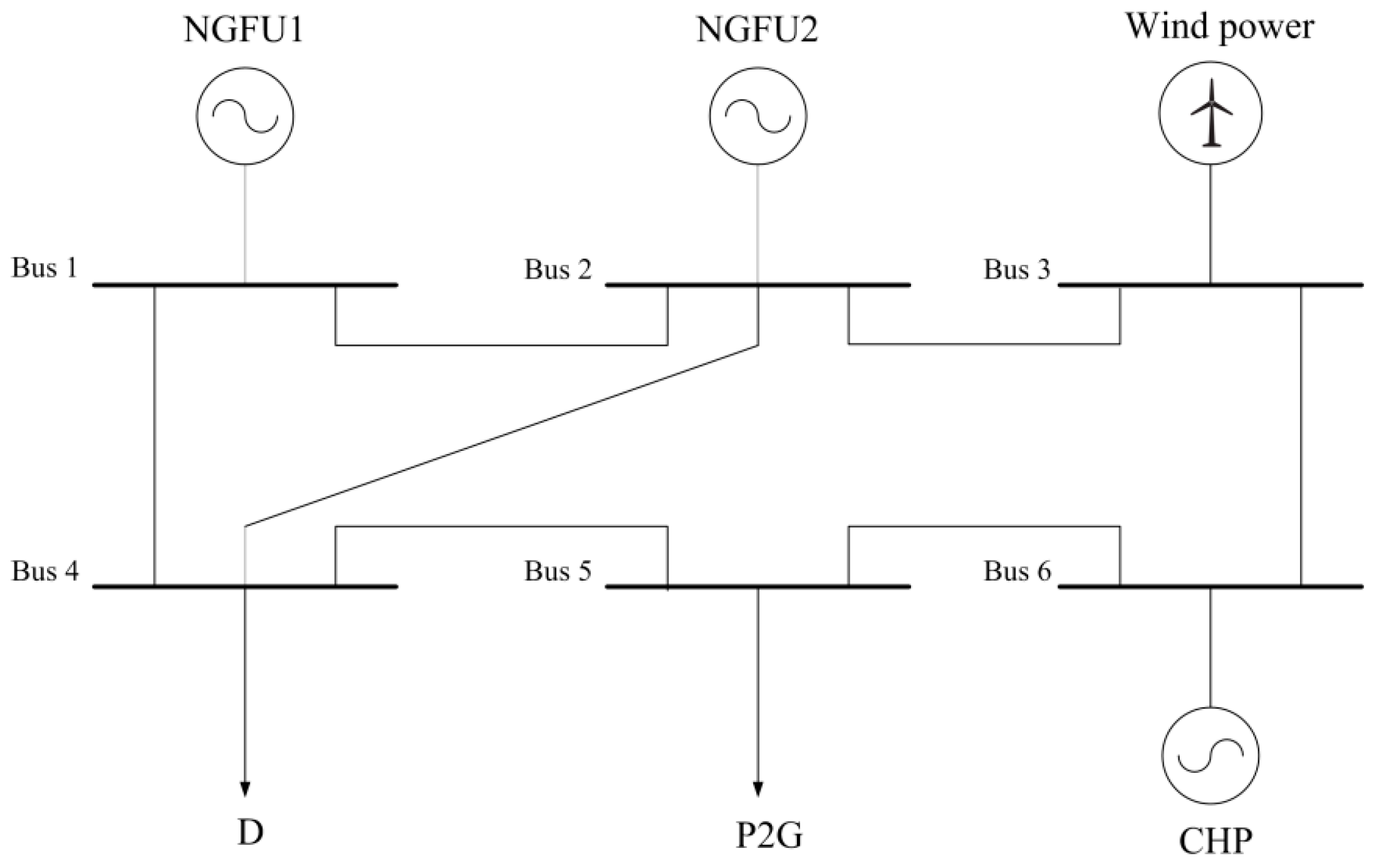
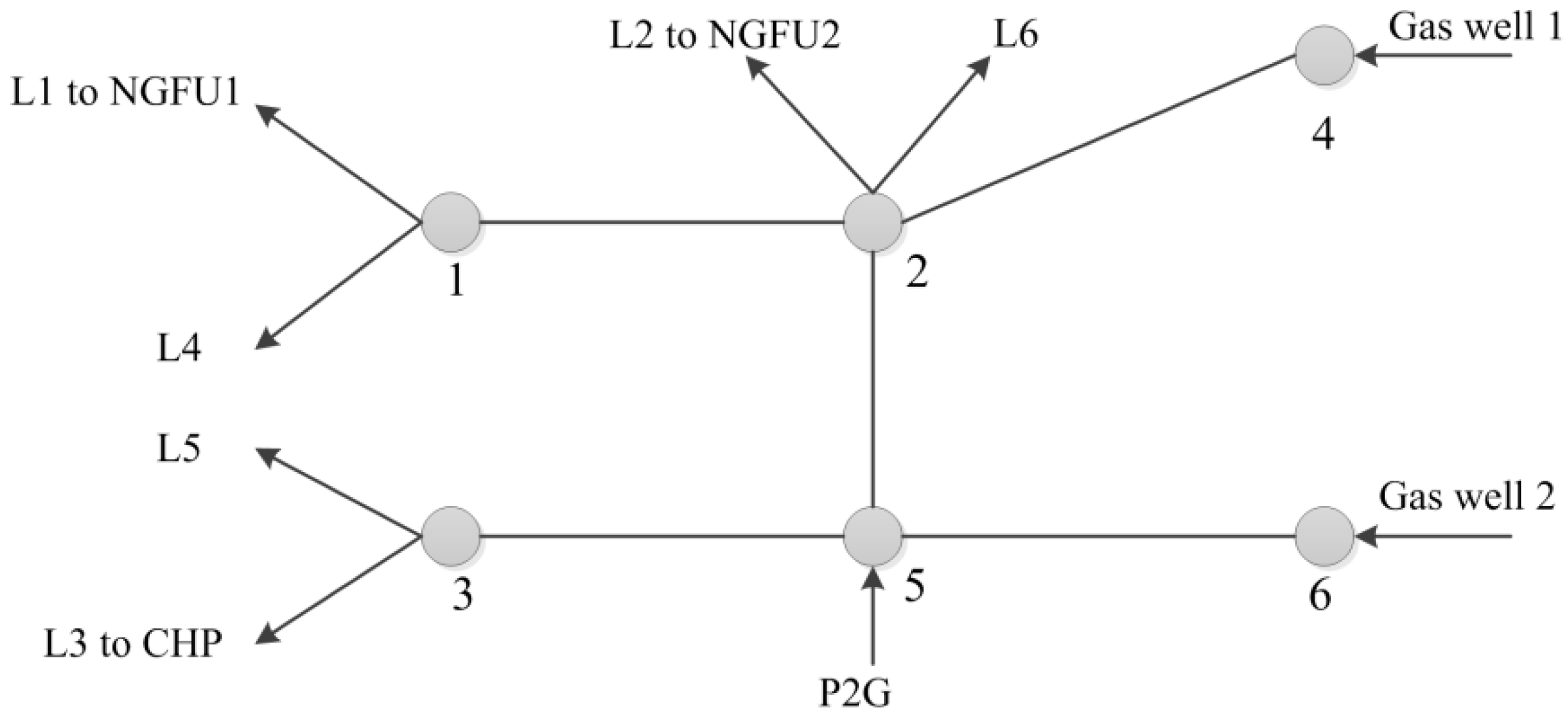

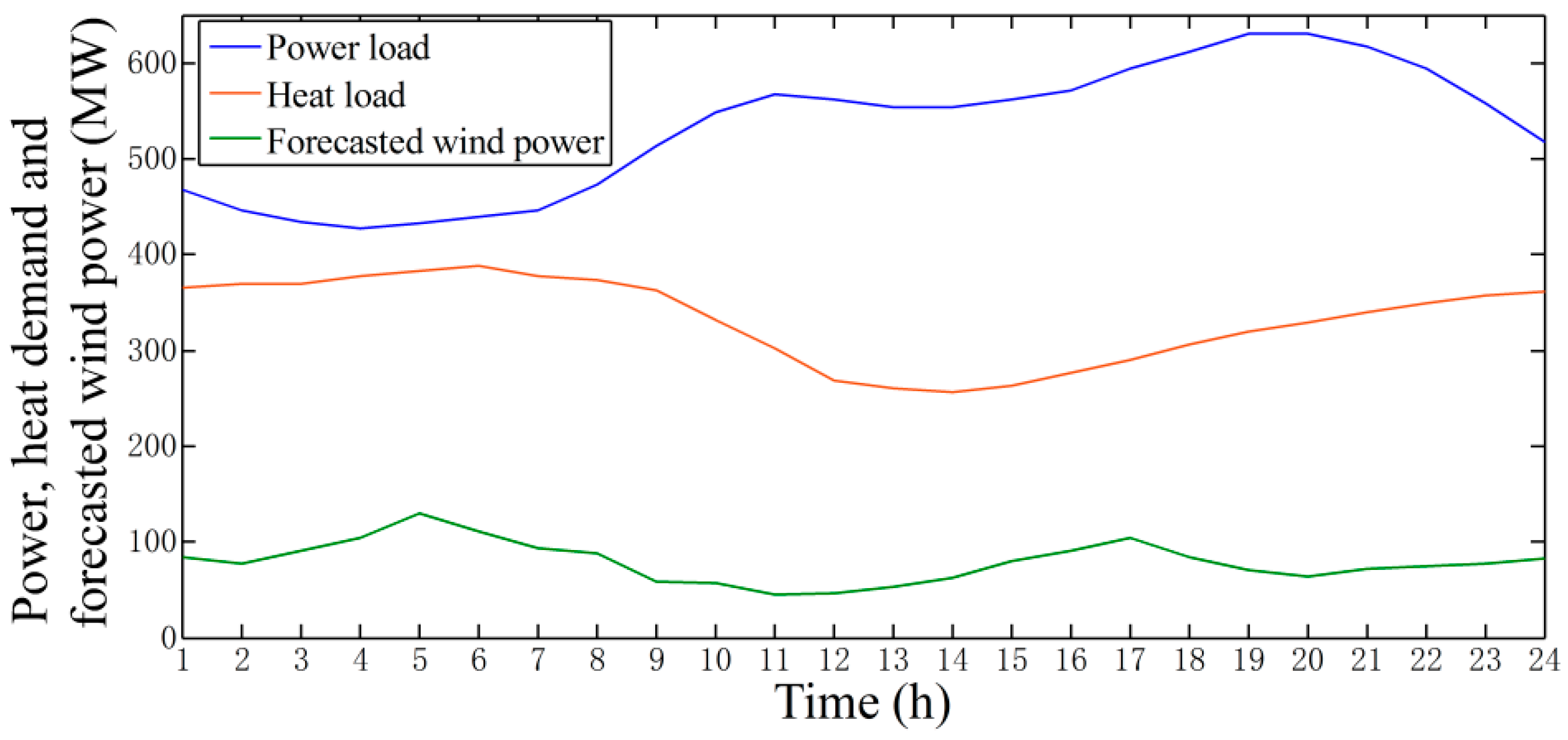
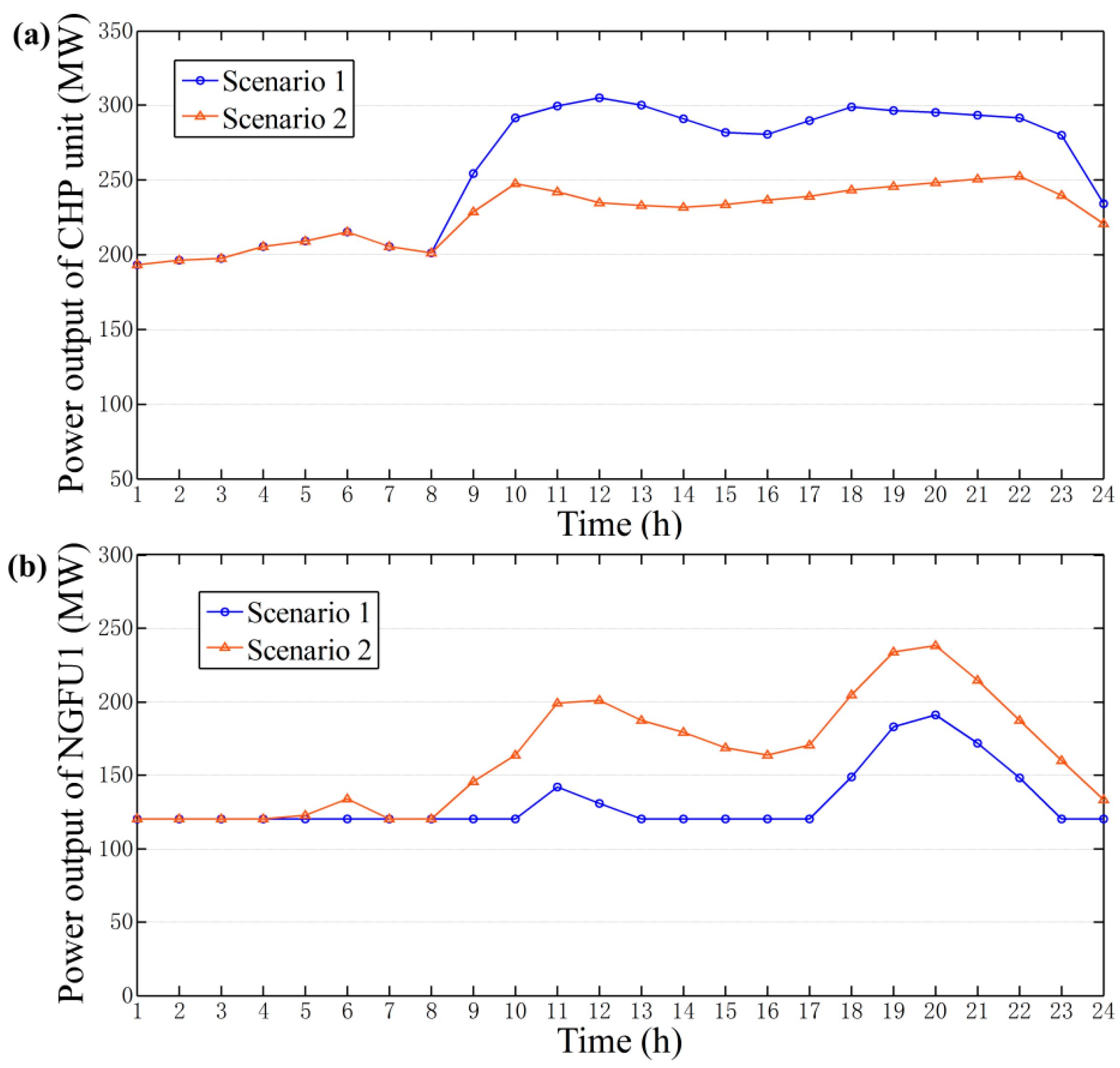
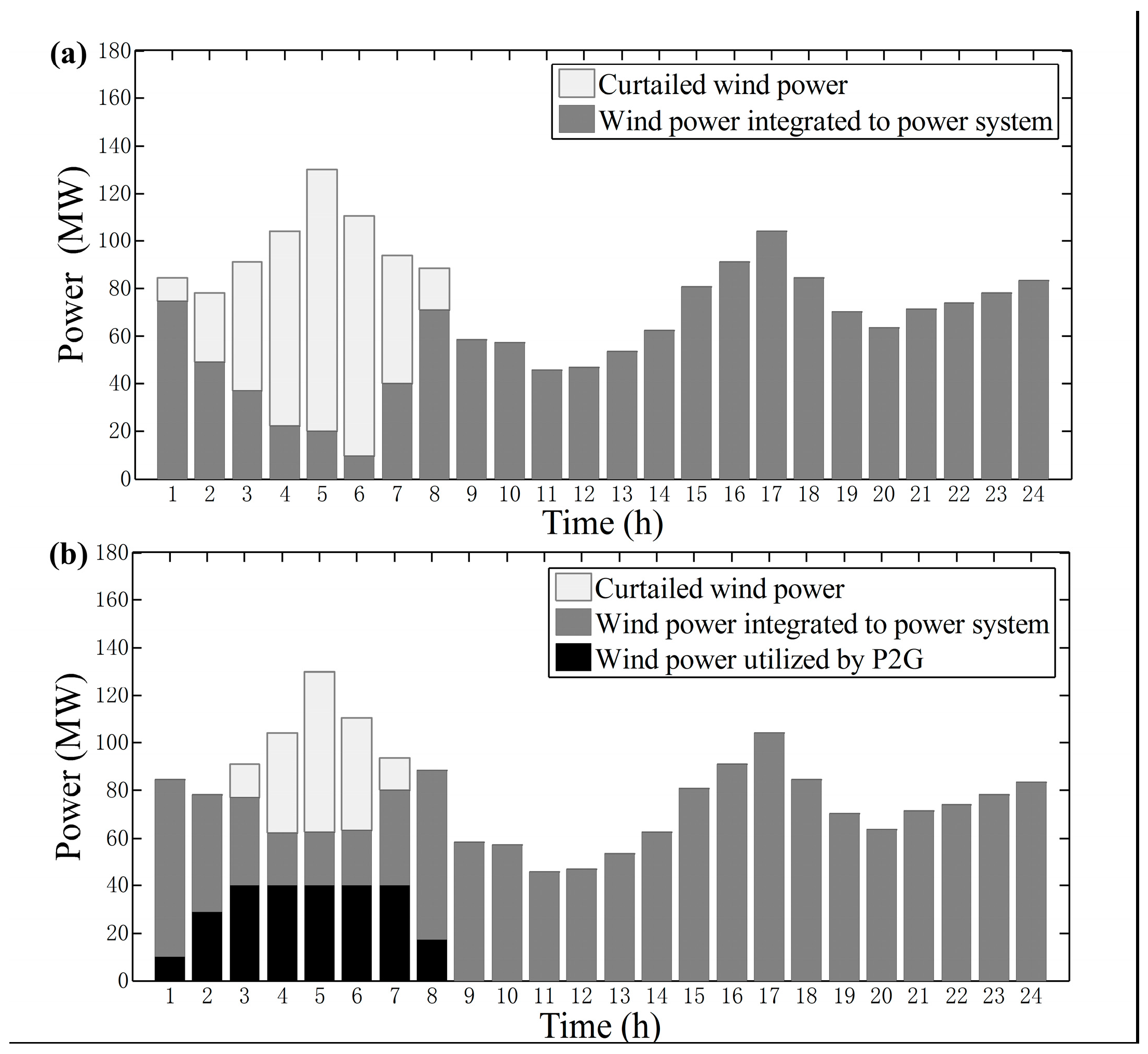
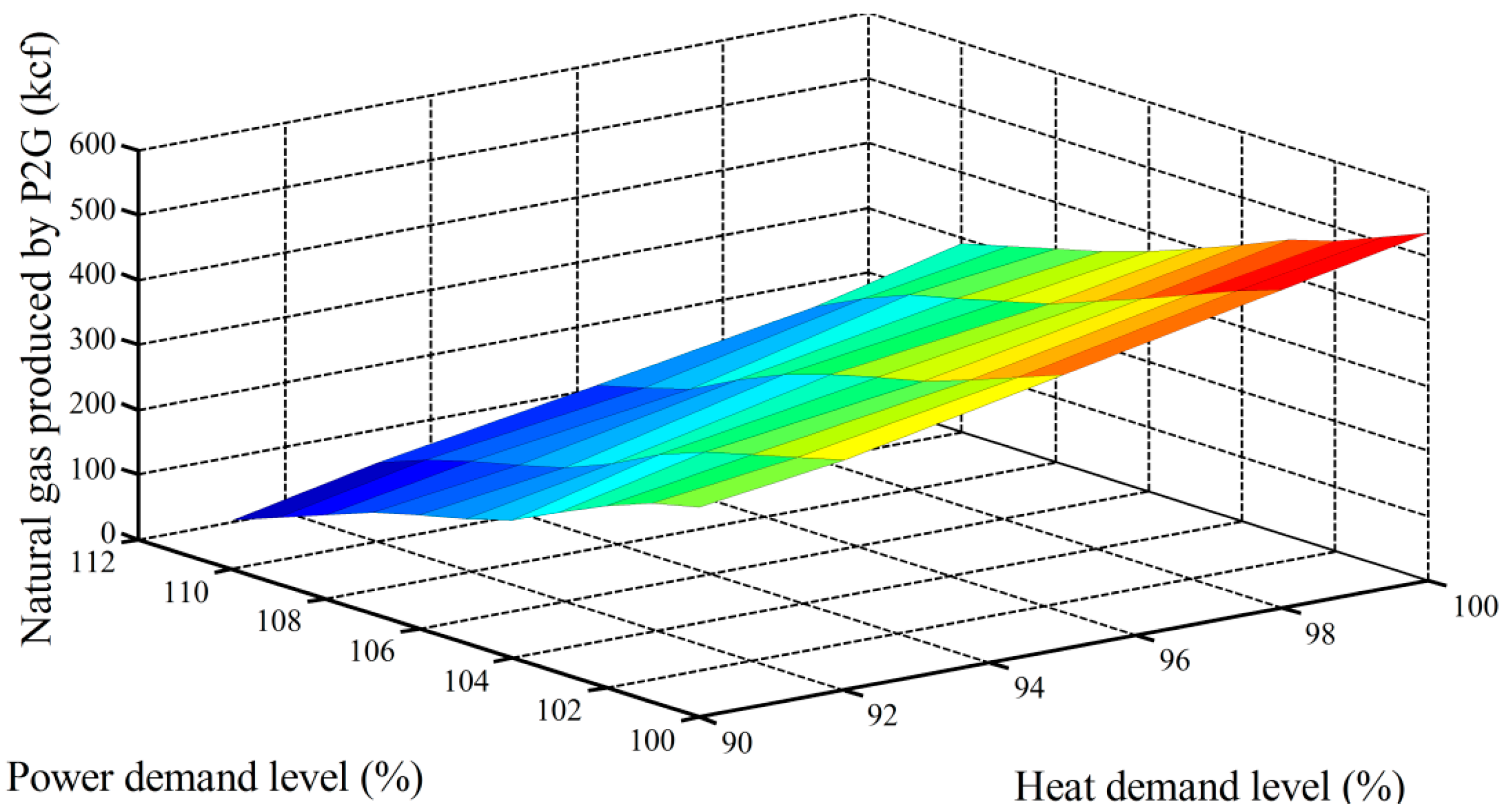

| NGFU1 | NGFU1 | CHP | |
|---|---|---|---|
| Maximum power capacity (MW) | 250 | 200 | 350 |
| Minimum power output (MW) | 120 | 80 | 175 |
| Maximum heat capacity (MW) | - | - | 450 |
| Maximum ramping rate (MW/h) | 50 | 50 | 70 |
| Gas Well 1 | Gas Well 2 | L4 | L5 | L6 | |
|---|---|---|---|---|---|
| Natural gas injected (kcf/h) | 1500–5000 | 2000–5000 | −2500 | −1700 | −1000 |
| Scenario 2 | Scenario 3 | |
|---|---|---|
| Fuel cost | 352,730$ | 347,570$ |
| Wind power consumed by P2G | 0 | 256 MWh |
| Wind power curtailment rate | 24.0% | 9.7% |
| Scenario 2 | Scenario 3 | |
|---|---|---|
| Fuel cost | 359,420$ | 355,440$ |
| Wind power consumed by P2G | 0 | 237 MWh |
© 2017 by the authors. Licensee MDPI, Basel, Switzerland. This article is an open access article distributed under the terms and conditions of the Creative Commons Attribution (CC BY) license (http://creativecommons.org/licenses/by/4.0/).
Share and Cite
Ye, J.; Yuan, R. Integrated Natural Gas, Heat, and Power Dispatch Considering Wind Power and Power-to-Gas. Sustainability 2017, 9, 602. https://doi.org/10.3390/su9040602
Ye J, Yuan R. Integrated Natural Gas, Heat, and Power Dispatch Considering Wind Power and Power-to-Gas. Sustainability. 2017; 9(4):602. https://doi.org/10.3390/su9040602
Chicago/Turabian StyleYe, Jun, and Rongxiang Yuan. 2017. "Integrated Natural Gas, Heat, and Power Dispatch Considering Wind Power and Power-to-Gas" Sustainability 9, no. 4: 602. https://doi.org/10.3390/su9040602






